
William Williams, Pantycelyn, also known as William Williams, Williams Pantycelyn, and Pantycelyn, is generally seen as Wales's premier hymnist. He is also rated among the great literary figures of Wales, as a writer of poetry and prose. In religion he was among the leaders of the 18th-century Welsh Methodist revival, along with the evangelists Howell Harris and Daniel Rowland.

Felicia Dorothea Hemans was an English poet. Two of her opening lines, "The boy stood on the burning deck" and "The stately homes of England", have acquired classic status.

Priscilla Denise Levertov was a British-born naturalised American poet. She was a recipient of the Lannan Literary Award for Poetry.

Mary Robinson was an English actress, poet, dramatist, novelist, and celebrity figure. She lived in England, in the cities of Bristol and London; she also lived in France and Germany for a time. She enjoyed poetry from the age of seven and started working, first as a teacher and then as actress, from the age of fourteen. She wrote many plays, poems and novels. She was a celebrity, gossiped about in newspapers, famous for her acting and writing. During her lifetime she was known as "the English Sappho". She earned her nickname "Perdita" for her role as Perdita in 1779. She was the first public mistress of King George IV while he was still Prince of Wales.

Talgarth is a market town, community and electoral ward in southern Powys, Mid Wales, about 12 miles (19 km) north of Crickhowell, 19 miles (31 km) north-east of Brecon and 15 miles (24 km) south-east of Builth Wells. Notable buildings in the town include the 14th-century parish church and a defensive tower house. According to traditional accounts, Talgarth was the capital of the early medieval kingdom of Brycheiniog. It is in the historic county of Brecknockshire. In 2011, it had a population of 1,724.

The Presbyterian Church of Wales, also known as the Calvinistic Methodist Church, is a denomination of Protestant Christianity in Wales.

Ann Griffiths was a Welsh poet and writer of Methodist Christian hymns in the Welsh language. Her poetry reflects her fervent Christian faith and thorough scriptural knowledge.
Jane West, was an English novelist who published as Prudentia Homespun and Mrs. West. She also wrote conduct literature, poetry and educational tracts.

Ann Gilbert was an English poet and literary critic. She gained lasting popularity in her youth as a writer of verse for children. In the years up to her marriage, she became an astringent literary critic. However, she is best remembered as the elder sister and collaborator of Jane Taylor.

William Thomas, bardic name Islwyn, was a Welsh language poet and Christian clergyman. His best known poems were both called Yr Ystorm ['The Storm'], and were written in response to the sudden death of his fiancée.
Emma Tatham was a 19th-century English poet. Her work is seldom read today, but she was regarded in the Victorian era as a prodigy and a poetic genius.
Maria Abdy, née Smith, also known as Mrs Adby, was an English poet.
Jane Brereton (1685–1740) was a Welsh poet who wrote in English. She was notable as a correspondent for The Gentleman's Magazine.
Elizabeth Ogilvy Benger was an English biographer, novelist and poet. Some of her poetry had a strong social message.
Agnes Bulmer was an English poet. She is believed to have written the longest epic poem ever written by a woman. The piece, Messiah's Kingdom, took over nine years to complete.
Mehetabel Wesley Wright was an English poet. She was a member of the influential religious Wesley family.

Catherine Eliza Richardson was a Scottish author and poet who published a four-volume novel and three collections of verse.
Eliza Hamilton Dunlop was an Irish–Australian poet and songwriter, known for composing the poem "The Aboriginal Mother" among others. She was born in County Armagh, Ireland, and was raised by her grandmother and a guardian, after her father travelled to India and her mother died. Later, she travelled to India to visit her father and discovered that she had two Indian half-sisters. Her writing career began in Ireland while she was still a child. After moving to Australia, her works were published in newspapers there, some set to music by Isaac Nathan after he arrived in Australia in 1841.

Emily Augusta Patmore was a British author, Pre-Raphaelite muse and the inspiration for the 1854-1862 poem The Angel in the House.

Frances Maria Cecilia Cowper, sometimes known as Maria Frances, was a religious poet and part of the Madan-Maitland literary coterie.











